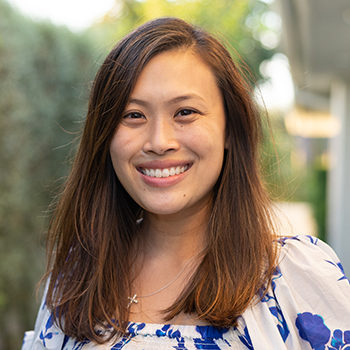In 2017, after joining my family’s foundation as the Director of Programs, I had the opportunity to participate in a “Meet the Funders” event hosted by the Asian Pacific Community Fund. At the time, I wasn’t the most seasoned grantmaker, but it had long been a desire of mine to meaningfully engage with the AAPI community, so I was particularly excited for the opportunity to participate in eight one-on-one sessions with AAPI nonprofit leaders during the event. I believed that as a result of those meetings, I’d have some new connections and make some recommendations to our board about programs that seemed interesting. However, these conversations opened my eyes and ears to the unique, culturally specific assets and particularized needs of the AAPI nonprofit landscape and started me on an ongoing journey of listening to and learning from the incredible leaders serving our precious AAPI communities.
At first, I was incredibly overwhelmed by the number of AAPI organizations that I became aware of, each of them providing critical services to our most vulnerable and hard-to-reach AAPI community members. Additionally, I became exasperated by the lack of resources that were available to these underserved communities. I further started to see a pervasive pattern: all these organizations, from those boasting multi-million-dollar annual budgets to the organizations with only one full time staff person, were all fighting for the same limited funding from a very small pool of funders. Sadly, this was creating an ecosystem that perpetuates a scarcity mindset, harbors unhealthy competition, and impedes positive community impact.
The Center for Effective Philanthropy (CEP) report, Overlooked (Part 1): Foundation Support for Asian American and Pacific Islander Leaders and Communities, documents these patterns through feedback and the experiences of AAPI leaders. These realizations raised a difficult question for me to grapple with. Oftentimes, as grantmakers, we rely on our nonprofit partners to tell us the problems they’re addressing; but how often do we ask ourselves if we are contributing to or creating new problems within the communities we serve?![]()
As funders, it is our responsibility to the AAPI community and other underrepresented communities to lead a philanthropic transformation to ensure that vulnerable and insular communities are seen, heard, valued, and protected. From that perspective I’d like to share three guiding principles that I have gleaned through my time working with our community leaders.
Guiding Principle #1: Lead with curiosity and cultivate a comprehensive understanding of AAPI communities. It’s well established that the AAPI community is extremely diverse, encompassing approximately 50 ethnic groups that speak over 100 languages. However, pervasive, generalized, and largely inaccurate perceptions of Asian Americans, which includes the myth of the Asian “model minority,” diminish the rich narratives and nuanced experiences of our unique AAPI community members. When comprehensive research with disaggregated data is collected, the socio-economic disparities within separate AAPI communities is undeniable and AAPI nonprofits are better equipped to illustrate the true assets and needs of the communities they serve. Here are some examples:
- A National Partnership for Women & Families’ report released earlier this year revealed that while the wage gap between Chinese and Indian women vs. white males is small or nonexistent, most other AAPI women are paid significantly less. For example, for every dollar paid to white males, Korean women are paid 86 cents, Filipina women are paid 83 cents, Vietnamese women 63 cents, Cambodian women 60 cents and Burmese women 49 cents.

- An Asian Americans Advancing Justice – Orange County report from 2018 highlighted educational disparities facing Native Hawaiian and Pacific Islander (NHPI) communities. Only 19 percent of NHPI have obtained a college degree or higher compared with 38 percent of the general population. NHPI high school graduation rates in Orange County are below average (83 percent versus the county average of 86 percent), while NHPI dropout rates countywide are identical to those of Blacks or African Americans (13 percent).
Guiding Principle #2: Balance the principles of sustainability, innovation, and collaboration. In this very moment, the identity of AAPIs is rapidly evolving. In addition to our diversity of languages, intergenerational complexities, wide-ranging educational and economic experiences, and increased interracial families, our dynamic community members continue to expand and introduce new interpretations of the AAPI experience. As funders, it’s critical that we support young AAPI social entrepreneurs, empower them to step into leadership roles, and address issues that are unique to their generation. However, the pursuit of innovation cannot overshadow the long-standing and ongoing needs of the community, which include culturally competent language services and multiple legal aid offerings. This type of work requires nonprofits to engage in a tremendous amount of community building in order to develop trusting relationships and may not be clearly expressed in the data typically used to measure success.
Additionally, funders tend to promote collaboration amongst the AAPI community without fully understanding the distinctions within our population. What might work for one AAPI ethnic group cannot be “duplicated and scaled” for another AAPI ethnic group. While there is an increasing gravitation towards younger generations readily identifying as “Asian Americans,” the AAPI community certainly is not monolithic. Encouraging AAPI nonprofits to collaborate should be done thoughtfully, and should also be reflected by funders in developing their own collective philanthropic strategies and activities to support the community.
Guiding Principle #3: AAPI and mainstream funders BOTH need to be reliable, engaged, and postured as long-term resource partners. Earlier this year, Asian American/Pacific Islanders in Philanthropy released a report about foundation funding for AAPI communities titled “Seeking to Soar.” This report revealed that for every $100 awarded by foundations for domestic work, only 20 cents is designated for AAPI communities. The CEP report corroborates this abysmal figure with their own data: almost two-thirds of foundation leaders say that they provide little or no grant dollars to organizations serving AAPI communities. Simply put, mainstream funders need to make the AAPI community more of a priority.
But the onus is on the AAPI community itself as well. We need to develop more of a cohesive and coordinated philanthropic network, led by our partners on the ground, to properly educate us on pressing concerns and to inform our giving strategies.![]() A report by FiveStone highlights five strategic shifts for foundations; one, notably, is to transition from being just supporters to engaging as network catalysts. This is how the philanthropic community needs to respond. Not simply committing dollars, but also being “primary strategic drivers” of the work ourselves. This requires more than just reactionary gifts or fulfilling of requirements and calls for dedicated funders who are willing to make this a long-term philanthropic priority that the AAPI community can depend upon, year after year, for desperately needed resources.
A report by FiveStone highlights five strategic shifts for foundations; one, notably, is to transition from being just supporters to engaging as network catalysts. This is how the philanthropic community needs to respond. Not simply committing dollars, but also being “primary strategic drivers” of the work ourselves. This requires more than just reactionary gifts or fulfilling of requirements and calls for dedicated funders who are willing to make this a long-term philanthropic priority that the AAPI community can depend upon, year after year, for desperately needed resources.
Vivian Long is the executive director for the Long Family Foundation, an intergenerational, private nonprofit organization that funds religious, educational, cultural, and research endeavors.




